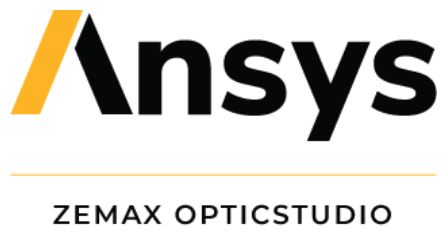
January 12th, 2023
1 Tools, Features, and Capabilities
1.1 Lumerical Sub-wavelength Dynamic Link DLL (Premium and Enterprise editions)
Enhanced support for 2D gratings with the Lumerical Sub-wavelength Dynamic Link DLL.
This new Diffraction DLL enables simulation of 2D gratings by dynamically linking to Ansys Lumerical FDTD. When rays hit a grating in Ansys Zemax OpticStudio, the diffraction efficiency is calculated using the Lumerical RCWA solver.
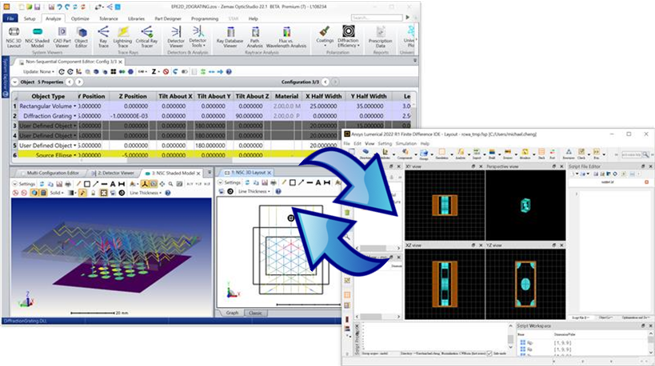
To run this DLL, the Lumerical FDTD needs to be installed on the same PC, so that this DLL can call Lumerical for calculation.
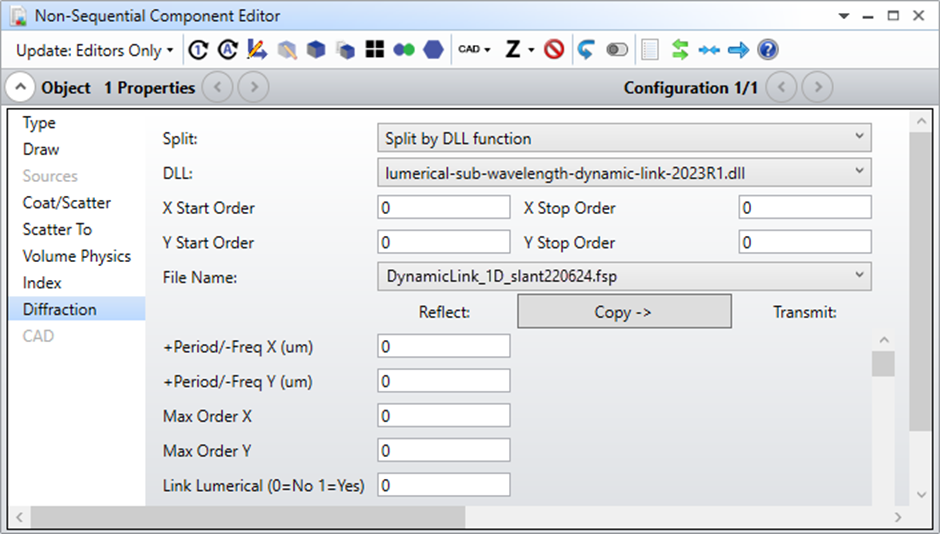
1.2 Lumerical Sub-wavelength DLL (All editions)
Accurately simulate a grating by importing Lumerical data from a static file.
This DLL allows users to simulate a grating by loading pre-calculated diffraction efficiency data saved in a JSON file. The contents of this file can be calculated by and exported from Ansys Lumerical FDTD (calculations use the Lumerical RCWA solver). Users can find more details about how to export this JSON file here: Speos Lumerical Sub-wavelength Model. Users can also find more information about importing the JSON file into OpticStudio using this DLL, search “How to load grating data from Lumerical into OpticStudio” here: Knowledgebase (zemax.com).
1.3 Composite Surface (All editions)
Tolerance surface irregularities for any physical surface.
The new Composite Surface capability enables you to easily create complex surface geometries in sequential mode by allowing the sag of any surface to be added to the sag of a base surface, for any surface types where real sag is used to characterize the behavior of the optical component. Any number of Composite Surfaces can be stacked together, and all the sags will be summed to the base surface.
This advanced functionality enables several new capabilities in OpticStudio, including the ability to directly tolerance the surface irregularity of any sag-based surface – with no workaround needed! Direct surface irregularity tolerancing has been enabled for all sag-based surfaces in the sequential mode of OpticStudio using the TEZI operand.
1.4 Non-Sequential Single Ray Trace (All editions)
Enables analysis and visualization to study ray propagation in an NSC optical system.
The new Single Ray Trace enables you to trace a single ray in non-sequential mode without affecting your original system. The NSC Single Ray Trace enables analysis and visualization on a ray-by-ray basis to study the ray propagation in a non-sequential optical system. This is important for understanding the behavior of complex imaging systems being modeled in non-sequential mode, such as exit pupil expanders used in AR systems.

1.5 NSC Geometric MTF (All editions)
Calculate Geometric MTF on a detector in non-sequential mode.
This new feature allows users to calculate the Geometric MTF from the irradiance distribution on a detector in non-sequential mode. This feature replaces the Geometric MTF option in the Detector Viewer.
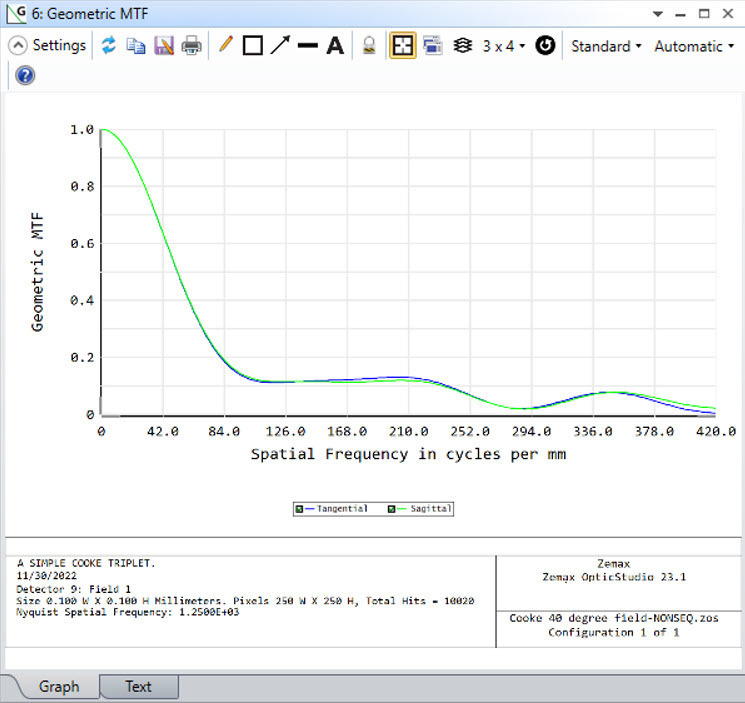
The Geometric MTF is calculated using all rays coming from all sources that land on the detector, not just rays originating from a single source in the system. Therefore, the results may differ between sequential and non-sequential calculations of the Geometric MTF. The results may also differ if the non-sequential system includes mechanical components with which rays may interact or if the system is set for rays to be split or scattered.
Importantly, the Geometric MTF in non-sequential mode is calculated in cycles/millimeters, regardless of the chosen MTF Units in the System Explorer.
1.6 NSC Surface Sag (All editions)
Easily analyze the shape of any complex surface in non-sequential mode to ensure manufacturability.
This new built-in analysis in OpticStudio uses non-sequential ray tracing to calculate the sag values of a specified face of an object defined in the Non-sequential Component Editor (NSCE).
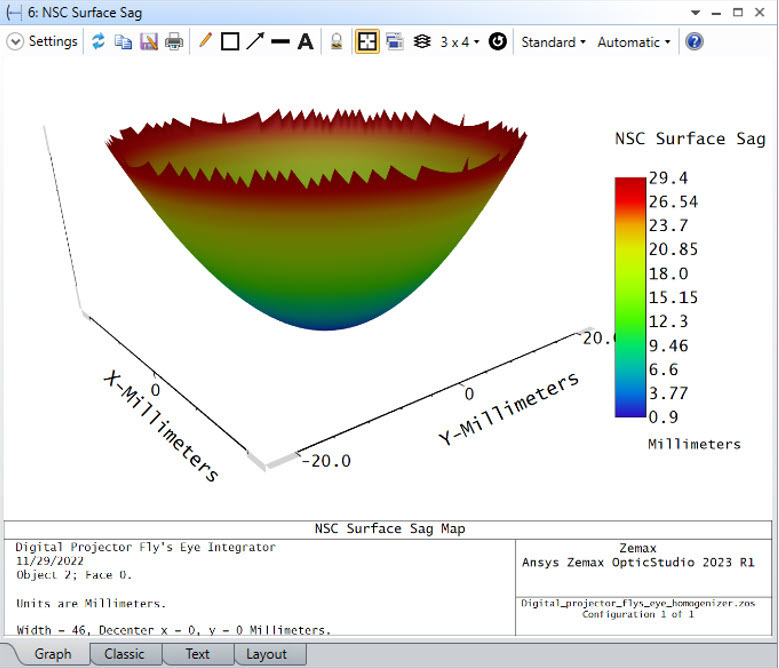
The rays used for the sag calculation can be visualized in the Layout tab, which greatly assists with troubleshooting setup of the analysis.
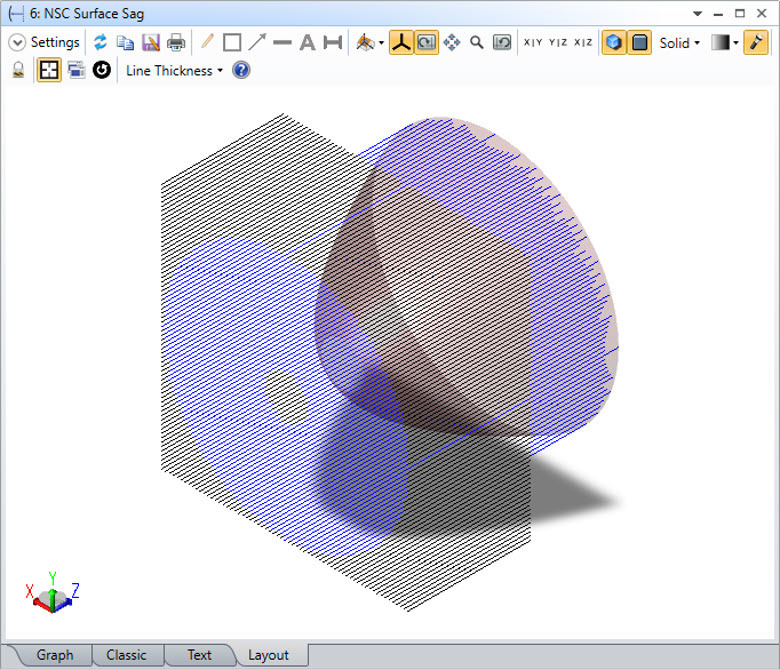
The settings for this analysis include a “Keep Object Tilts” checkbox, which enables preservation of the object’s original x and y tilt. If this box is checked, the analysis will account for the tilts of the object when calculating the sag, and they’ll be ignored if this box is unchecked.
The analysis also lets the user remove the base radius, best-fit sphere, base sag, average sag, or minimum sag. The average and minimum sag allow for piston removal or to anchor the sag map to the lowest sag value.
1.7 Updates to Export Speos Lens System (All editions)
Added features include skip system reversal, configuration options, and sensor map visualization.
New features include the ability to skip the automated reversal step during the computation of systems that are reversed manually and the ability to export a specific configuration from a multi-configuration system. The ability to save specific parameters in the Speos Exporter Output Settings has also been included in the User Interface. The parameters that can be saved include distortion, variable entrance pupil position, sharpness losses, depth of field and resolution.
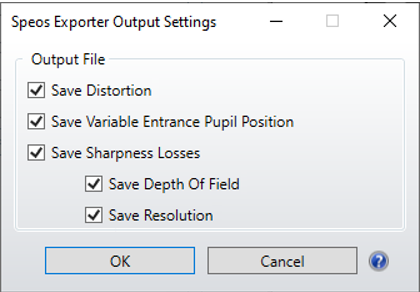
A new sensor layout has been added for an improved visual representation of the image plane sampling. Output distortion file settings are featured to customize the output data by including or excluding specific input parameters.
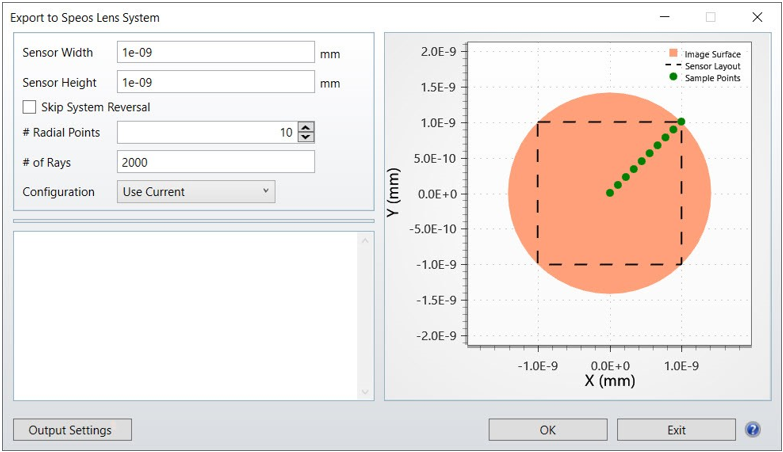
1.8 Prepare for OpticsBuilder: Hard Aperture (All editions)
Improvements to NSC Hard Aperture for Stop surfaces.
A new feature has been added to improve the conversion of Stop surfaces to NSC Apertures during the creation of ZBD files. This feature allows users to determine whether the Stop surface is converted to either an annulus ring (for circular apertures) or a rectangular aperture in non-sequential mode when the Stop is not located on an optical component (i.e., is not the surface of a lens or a mirror).
The new mechanical Stop-half-width input enables the user to define the external diameter/width of the non-sequential objects.
The addition of the Status tab in Prepare for OpticsBuilder shows a log of events to help with error handling when preparing the ZBD files.
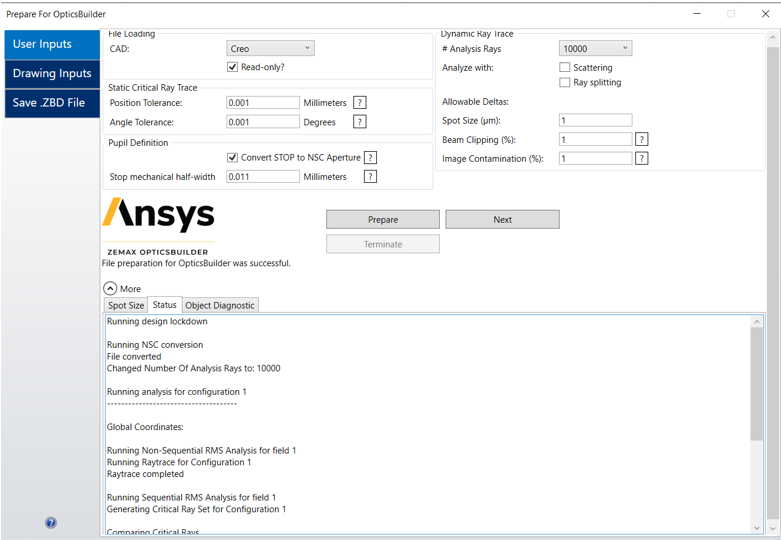
1.9 NSC Diffraction Properties (All editions)
Enhanced User Interface for 2-dimensional diffraction orders.
The user interface of the Diffraction tab within the Properties dialog of the Non-Sequential Component Editor has been updated to allow for separate specification of the start and stop orders in X and Y. This is necessary for accurate characterization of 2D gratings.
A new Copy button has also been added to the user interface that carries out a one-time copy from the Reflect to the Transmit settings for the grating. This allows users to define parameters for both Reflect and Transmit when setting up grating parameters.
The new user interface allows users to customize their diffraction DLLs to better match their requirements. Users can check the built-in Diff2DSample.dll and its source code Diff2DSample.cpp to learn more about how to build a DLL with this new user interface.
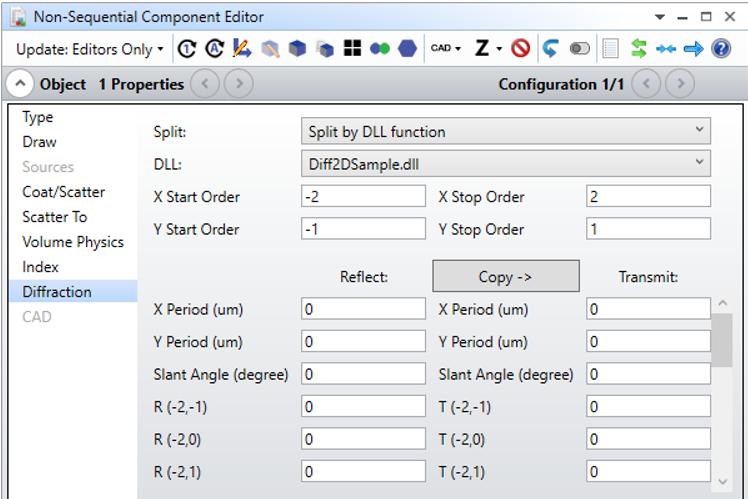
1.10 STAR: Active Rigid Body Motions (RBMs) (Enterprise Edition)
New capability for Rigid Body Motions (RBMs).
The Structural, Thermal, Analysis and Results (STAR) functionality in the Enterprise edition of Ansys Zemax OpticStudio now features a new capability to decouple rigid-body motions (RBMs) from higher-order surface deformations in the structural datasets that are loaded from any finite element analysis platform. New checkboxes have been added to the Structural Data Summary that enable you to turn on or off the contributions of Fitted Deformations (excluding RBMs) or Extracted RBMs for each surface. These features enable or disable the contributions without needing to modify the FEA datasets directly.
Also, a new Structural Options drop-down menu is available to enable and disable the Fitted Deformations and Extracted RBMs for all surfaces with one click.

1.11 UDA on NSC Extended Polynomial Lens (All Editions)
Additional support for User Defined Aperture (UDA).
A User Defined Aperture (UDA) will now be added on top of the Extended Polynomial Lens object in non-sequential mode when creating this object during conversion of an Extended Polynomial sequential surface mirror with a user-defined aperture on it. This is important for modeling complex geometries supported by the Extended Polynomial surface and lens, which often require specific apertures to deal with effects at the surface boundaries.
1.12 Export to PanDao (All Editions)
Determine the optimal fabrication chain at any point during the optical design process.
PanDao (https://pandao.ch/) has developed a browser-based tool for assessing the impact of lens fabrication methods on performance and cost. These assessments are created using relevant data from the optical design. Engineers are currently required to extract the relevant data from their optical models and input these into the PanDao toolset manually.
The Export to PanDao tool is a ZOS-API standalone application that helps automate the process by extracting the relevant data from an OpticStudio lens file and writing this to a JSON file that can subsequently be read in by the PanDao toolset.
This tool currently supports on-axis systems that use Standard surfaces that are spherical (the conic constant must be zero), Even Asphere, Extended Asphere, and Extended Odd Asphere surface types. Both refractive and reflective surfaces are supported.
1.13 License Borrowing (All Editions)
Continue to work offline when being unable to contact the license server.
A new Ansys Client Settings utility has been added to enable borrowing an Ansys Zemax license that can be used without your computer making contact with the license server. This is helpful in cases where the client workstation won’t be able to directly communicate with the license server for a while, such as a laptop going to a remote worksite or someone working temporarily from home without a VPN. See the built-in help file for details.
1.14 More File Types Supported by Project Directories (All Editions)
The Project Directory now supports even more of your files.
Introduced in Zemax OpticStudio 21.3, The Project Directory system enables easy packaging and storage of important Zemax files so that they can be easily accessed a manipulated on a project-by-project basis. A Project Directory can be created from an existing OpticStudio design by using the Convert to Project Directory button in the File tab.
With Ansys Zemax OpticStudio 2023 R1, Project Directories now also support the following file types:
- Physical Optics Propagation (POP) files (.ZBF, .ZMM)
- Objects/Sources/IESNA files (.IES, .DAT)
- Configuration files (.CFG)
- Objects/Sources/Source Files (.CRS, .FFD, .RRD, .DAT, .SDF)
2 Performance and Stability Improvements
-
Export to Speos Lens System – Model Glasses are now supported by the Export to Speos Lens System tool and will no longer be converted to the closest material found in the “Catalogs to Use” section of the System Explorer. This improves the behavior for systems that previously produced a degraded performance when no good match was available for the material.
3 Libraries and Catalogs
3.1 Catalog Updates (All Editions)
Get the latest material catalogs from CDGM, GBJ, SABIC, NHG, Schott, Optotune, VIAOPTIC, and Acktar.#
Material Catalogs
-
The CDGM material catalog has been updated:
-
Added 3 new glasses: D-ZK21, D-ZLaF85LN, F4GTi.
-
Low softening series glass (D-) provides refractive index data of two annealing rates, in which the serial number suffix "-25" indicates that the refractive index data of the glass is 25℃ corresponding data, and glasses without suffix is 4℃/h corresponding data.
-
Expand the index range to 2325nm for 73 glasses below, and change their dispersion formula to Sellmeier 1:
H-QK1, H-K1, H-K2, H-K3, K4A, H-K7, H-K8, H-K11, H-K50, H-K51, H-ZPK1A, H-ZPK3, H-BaK1, H-BaK2, H-BaK3, H-BaK4, H-BaK5, H-BaK8, H-ZK1, H-ZK2, H-ZK3A, H-ZK5, H-ZK7A, H-ZK8, H-ZK10, H-ZK14, H-ZK21, H-LaK1, H-LaK3, H-LaK4L, H-LaK6A, H-LaK8A, H-LaK11, H-LaK12, H-LaK50A, H-LaK53A, H-LaK59A, H-KF6, H-QF1, H-QF6A, H-QF8, H-QF50, H-QF50A, H-QF56, H-F2, H-F4, H-F13, H-BaF2, H-BaF3, H-BaF5, H-BaF6, H-ZBaF1, H-ZBaF3, H-ZBaF20, H-ZBaF50, H-ZF1, H-ZF5, H-ZF50, H-LaF1, H-LaF2, H-LaF3B, H-LaF4, H-LaF4GT, H-LaFL5, H-LaF7, H-LaF51, H-LaF62, H-ZLaF1, H-ZLaF50D, H-ZLaF51, H-ZLaF55C, H-ZLaF71AGT, H-ZLaF89L. -
The refractive index temperature range of 41 glasses was expanded from (-40~80) ℃ to (-60~140) ℃, and the refractive index temperature coefficient constant was revised:
H-K2, H-K8, H-ZPK1A, H-ZPK3, H-BaK6, H-ZK9B, H-ZK11, H-ZK14, H-ZK20, H-ZK50, H-ZK50GT, H-LaK5A, H-LaK12, H-LaK52, H-LaK53A, H-LaK59A, H-QF3, H-F1, H-F4, H-F13, H-F51, H-BaF4, H-ZBaF16, H-ZF3, H-ZF6, H-ZF7LA, H-ZF7LAGT, H-LaF3B, H-LaF6LA, H-LaF10LA, H-LaF50B, H-LaF52, H-LaF53, H-ZLaF75A, D-FK61, D-ZPK1A, D-ZK2L, D-ZF10, D-ZLaF52LA, D-ZLaF67, D-ZLaF85L.
-
-
The BIREFRINGENT material catalog has been updated:
-
Corrected the fit formula and parameters for Quartz and Quartz-E to match the definition in the original referenced paper T. Radhakrishnan, ‘‘Further Studies on the Temperature Variation of the Refractive Index of Crystals,’’ Proc. Indian Acad. Sci. A33: 22 – 34 (1951)
in Handbook of Optics, Vol. II.
-
-
The GBJ material catalog has been updated:
-
The refractive index test wavelength has been extended from the original 1014nm to 1692nm, and the corresponding dispersion formula constants are updated correspondingly. The extended materials include: H-QK3L, H-ZK10L, H-ZF13, H-LaK51, H-K9L, H-ZK21, H-ZF50, H-ZF5, H-ZK3, ZF1, H-ZF6, H-ZLaF52, H-ZK9A, ZF2-2, H-ZBaF50, H-ZLaF71, H-ZK11, ZF7L, H-F2, H-ZLaF76, H-LaK7A, H-LaF2, H-F13, H-ZF88, H-ZBaF21, H-LaK59, H-LaF3, H-ZLaF50E, H-ZF2, H-ZBaF1, H-LaF10, H-ZPK2, H-LaF50, H-ZBaF20, H-LaK8A, H-ZPK1, H-ZF1, H-ZF3, H-ZF7L, H-ZLaF4L, H-ZK6, H-ZF4, H-ZLaF55, H-LaK53, H-ZK7, H-ZF12, and H-ZLaF90.
-
The temperature range of refractive index coefficient has been expanded from -40℃-80℃ to -60℃-120℃, and the corresponding refractive index temperature coefficient constant is updated correspondingly. The updated materials include: H-QK3L, H-ZK10L, H-ZF13, H-LaK51, H-K9L, H-ZK21, H-ZF50, H-ZF5, H-ZK3, ZF1, H-ZF6, H-ZLaF52, H-ZK9A , ZF2-2, H-ZBaF50, H-ZLaF71, H-ZK11, ZF7L, H-F2, H-ZLaF76, H-LaK7A, H-LaF2, H-F13, H-ZF88, H-ZBaF21, H-LaK59, H-LaF3, H-ZLaF50E, H-ZF2, H-ZBaF1, H-LaF10, H-ZPK2, H-LaF50, H-ZBaF20, H-LaK8A, H-ZPK1, H-ZF1, H-ZF3, H-ZF7L, H-ZLaF4L, H-ZK6, H-ZF4, H-ZLaF55, H-LaK53, H-ZK7, H-ZF12, and H-ZLaF90.
-
Eight new high-permeability materials were added, mainly to update their internal transmittance: H-LaK2C, H-ZF4GT, H-ZF7LGT, H-ZFGT, H-ZF13GT, H-ZF52AGT, H-ZF62GT, H-ZF72GT, and H-ZF88GT.
-
Melting frequency and price coefficient have been updated for all materials.
-
-
The BIREFRINGENT material catalog has been updated:
-
Corrected the fit formula and parameters for Quartz and Quartz-E to match the definition in the original referenced paper T. Radhakrishnan, ‘‘Further Studies on the Temperature Variation of the Refractive Index of Crystals,’’ Proc. Indian Acad. Sci. A33: 22 – 34 (1951)
in Handbook of Optics, Vol. II.
-
-
The SABIC material catalog has been updated:
-
Added a new resin (EXTEM RH1016UCL) to the SABIC thermos-optical polymers catalogue. EXTEM™ RH1016UCL resin is a near-IR transparent thermoplastic with a glass transition temperature of 280°C. This injection moldable resin can produce complex optical lens assemblies while maintaining dimensional stability during 260°C peak temperature solder reflow assembly.
-
Changed the minimum wavelength to 300 nm for LEXAN_CXT17 and LEXAN_CXT19.
-
-
The NHG material catalog has been updated:
-
Added new materials H-FK76, H-LaK9, H-LaF50B, H-LaF56, H-ZLaF68L, H-ZLaF86, D-ZK3L-M90 and D-ZF93.
-
Updated temperature coefficients of refractive index of D-K9, refractive index of each band, dispersion, temperature coefficients of refractive index and phosphate resistance RP of H-LaK77, density of H-ZK21.
-
Updated thermal expansion coefficient α-50/80℃ of H-PK63, H-PK65, H-ZK21, H-LaK77, D-ZK3L and D-ZF10, thermal expansion coefficient α100/300℃ of H-PK63, H-LaK77 and D-ZF10.
-
Updated internal transmittance of H-ZK21, H-LaK50A, H-ZF72GT, H-ZF75GT, H-ZBaF50, H-LaF2, H-ZLaF54, H-ZLaF82 and D-ZLaF52N-M170.
-
Updated relative price and melting frequency of most materials.
-
-
The Schott material catalog has been updated:
-
Added new materials N-SF6Q2, SF3, N-LAK28, BK7G18, F2G12, SF6G05, LAK9G15, K5G20, LF5G19, N-LASF55, F2HTi, and N-SK5HTi.
-
Added CTE(20,300) for SF6G05.
-
Added dn/dT data for F2G12 and LAK9G15.
-
Corrected Abbe number for SF6G05.
-
-
The Optotune material catalog has been updated:
-
New catalog with 4 optical liquids: OL1024, OL1126, OL1129, OL1224.
-
Lens Catalogs
-
The OPTOTUNE lens catalog with 5 different models of focus-tunable liquid lenses has been added:
-
All focus-tunable liquid lenses emulate the human eye by producing focus changes by adjusting the curvature of a variable surface instead of axially shifting a rigid lens.
-
For each lens type, three different models are provided to represent three specific focus states of the lens: MAX represents the maximum focal power state (shortest positive focal length), MIN represents the minimum focal power state (shortest negative focal length), and MID represents the zero focal power state (infinite focal length).
- Available lens types:
-
EL-12-30-16D: Compact and fast electrically tunable lens. Focal power range is -6 to +10 dpt. Clear aperture is 12mm. Settling time is 10ms. Typical applications are C-mount lenses, machine vision, ophthalmology
- EL-16-40-5D: Large aperture, fast electrically tunable lens. Focal power range is -2 to +3 dpt. Clear aperture is 16mm. Settling time is 20ms. Typical applications are C-mount lenses, machine vision, microscopes
- EL-16-40-20D: Large aperture, high focal power range, electrically tunable lens. Focal power range is -10 to +10 dpt. Clear aperture is 16mm. Settling time is 40ms. Typical applications are zoom lenses, ophthalmology
- EL-3-10-26D: Small aperture, high focal power range, ultra-fast, electrically tunable lens. Focal power range is -13 to +13 dpt. Clear aperture is 3mm. Settling time is 4ms. Typical applications are S-mount lenses, code readers, lasers, oral scanners
- ML-20-37-36D: Large aperture, high focal power, manually tunable lens. Focal power range is -18 to +18 dpt. Clear aperture is 20mm. The lens can be actuated manually by rotating the outer diameter. Yet, it can also be automated by a gear drive. Typical applications are on benchtop optical systems and in ophthalmology to correct short and far sightedness
-
-
-
The VIAOPTIC material catalog has been updated:
-
New catalog containing 8 stock lenses.
-
Viaoptic is your specialist for plastic optical components. Vialens standard lenses from Viaoptic for collimation of narrowband light sources are ideally suitable for lasers of specific wavelengths available with different focal lengths.
- This catalog replaces the previous Philips Stock Lens Catalog, as that catalog has become obsolete since their acquisition of the laser collimation lens business of Helvoet/Philips.
-
Scatter Catalogs
-
Acktar:
-
16 new BSDF Scatter profiles have been added: Vacuum Black IR & VIS, Magic Black IR & VIS, Fractal Black IR & VIS, Lambertian Black IR & VIS, MaxiBlack IR & VIS, Metal Velvet IR & VIS, Spectral Black IR & VIS, Hexa Black IR & VIS
-
3.2 Deprecated RSMX and ISX Libraries (All Editions)
These features are deprecated and will be removed in July 2023.
As of the 2023 R1 release the RSMX and ISX libraries are deprecated, and they will be removed from OpticStudio in July 2023). The reason for depreciation is that these libraries rely on obsolete Microsoft components that could potentially introduce IT or security vulnerabilities in the future. To replace the ISX libraries, new BSDF scatter libraries will be made available in Ansys Zemax OpticStudio in a future release, based on a format that can be easily updated and maintained in a secure manner.
A small set of features in OpticStudio rely on the presence of the RSMX and ISX libraries in the software, and these features are also now deprecated (and will subsequently be removed in the 2023 R2 release). Some of these features have been moved under the Zemax Lab Group > Deprecated Features button in the Help tab of the OpticStudio UI, as shown below:
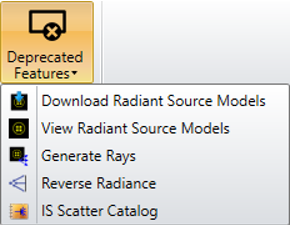
In addition to the features shown in the image above, the REVR Merit Function Operand and the ReverseRadiance Detector and Target Objects are also deprecated.
4 Bug Fixes
- Prepare for OpticsBuilder – Fixed an issue where Prepare for OpticsBuilder shows an error when converting a SEQ file, while the manual process of using the Convert to NSC Group tool and then Prepare for OpticsBuilder does work.
-
Text tab in analysis windows – Fixed an issue when a crash could occur by double clicking to update the text tab of an analysis window.
-
Solves – Fixed an issue where some solve parameters could be cut off due to incorrect solve window sizing.
-
Undo/Redo – Fixed an issue when the Project Directory is enabled for a lens system and an undo or redo operation can fail to locate external data files (e.g., CAD parts).



